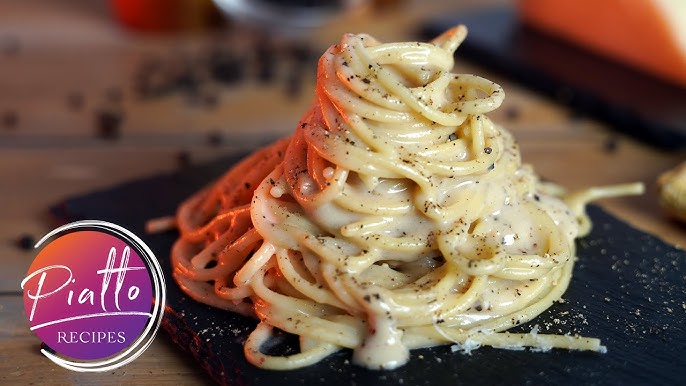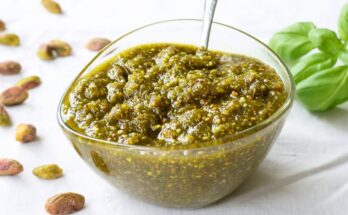Cacio e Pepe Recipe: Cacio e Pepe, meaning “cheese and pepper,” is one of the simplest yet most exquisite dishes of Roman cuisine.
This traditional Italian recipe highlights the beauty of minimalism, relying on just three primary ingredients: pasta, Pecorino Romano cheese, and freshly cracked black pepper.
Despite its simplicity, Cacio e Pepe demands precision and technique to achieve its signature creamy texture without adding cream. Intrigued? Let’s dive into the origins and then walk through each step to master this timeless classic.
Ingredients for Cacio e Pepe
To create a restaurant-quality Cacio e Pepe, you need only a handful of high-quality ingredients. Here’s what you’ll need:
Essential Ingredients:
- Pasta: Spaghetti, bucatini, or tonnarelli are the most traditional choices.
- Pecorino Romano cheese: This sharp and salty cheese is non-negotiable.
- Black pepper: Freshly ground for maximum flavor.
- Salt: For the pasta water.
Why These Ingredients Matter:
Each ingredient plays a specific role in building the dish’s signature flavor profile. Opt for Pecorino Romano rather than Parmesan to maintain the authentic taste, and use coarse black pepper for a bold, aromatic kick.
Kitchen Tools You’ll Need
For the best results, gather the following tools:
- A large pasta pot for boiling the pasta.
- A cheese grater, preferably microplane, for finely grating Pecorino Romano.
- A pepper grinder for freshly cracked pepper.
- A large skillet or sauté pan for combining ingredients.
- Tongs to mix and serve the pasta.
Pro Tip: A pasta pot with a strainer insert makes it easier to save that liquid gold—pasta water! You’ll use it to create the creamy sauce.
Step-by-Step Guide to Making Cacio e Pepe
1. Preparing Your Pasta Water
Start by boiling a large pot of water. Salt it generously but not excessively—since Pecorino Romano is already salty, you don’t want the dish to become overpowering.
Why Salt Matters: The salted water enhances the flavor of the pasta and becomes the base for the sauce. The starch released into the water also helps emulsify the cheese and pepper mixture.
2. Cooking the Pasta Perfectly
Add your pasta of choice to the boiling water and cook it until “al dente.” Refer to the package instructions for timing, but start checking a minute or two early.
How to Test: Pull out a strand and bite it. It should be tender but with a slight firmness in the center.
3. Creating the Cheese and Pepper Mixture
While the pasta cooks, grate a generous amount of Pecorino Romano cheese into a large bowl. Meanwhile, toast freshly cracked black pepper in a dry skillet over medium heat. Toasting intensifies its flavor and adds a subtle smokiness to the dish.
Tip for Success: Keep stirring the pepper as it toasts to prevent it from burning.
4. Combining Ingredients for a Creamy Sauce
Once the pasta is ready, reserve 1–2 cups of pasta water before draining. Add a ladle of hot pasta water to the bowl of grated Pecorino Romano, stirring quickly to form a smooth paste.
The Secret: Slowly add the pasta water to control the sauce’s consistency. Use the starchy water to create an emulsion with the cheese and pepper.
Add the cooked pasta to the skillet with the toasted pepper and mix thoroughly. Gradually pour the cheese mixture over the pasta, tossing vigorously with tongs to coat every strand.
5. Serving the Dish
Divide the pasta into serving bowls and sprinkle extra Pecorino Romano and black pepper on top. Serve immediately, as the dish is best enjoyed hot.
Optional Garnishes: Some prefer a drizzle of olive oil or a sprinkle of parsley for a modern twist, but purists stick to the basics.
Pro Tips for Perfect Cacio e Pepe
- Avoid Clumps: Grate the cheese finely and add hot (not boiling) pasta water slowly to prevent clumping.
- Keep It Simple: Avoid adding garlic, cream, or butter—authentic Cacio e Pepe doesn’t need them.
- Experiment with Pasta: While tonnarelli is traditional, other shapes like rigatoni or pappardelle can work beautifully.
Pairing and Serving Suggestions
Elevate your Cacio e Pepe experience with these pairing ideas:
Wine Pairings:
- A crisp white wine like Vermentino or Soave.
- A light red such as Chianti or Pinot Noir.
Side Dishes:
- A fresh arugula salad with lemon dressing.
- Crusty Italian bread to mop up the sauce.
Variations of Cacio e Pepe
Adding a Twist to the Classic Recipe
While traditionalists may argue against altering the original recipe, you can experiment with additions like:
- Lemon Zest: For a citrusy twist that brightens the dish.
- Garlic: Sautéed in olive oil for an extra layer of flavor.
- Butter: Adds richness to the sauce.
Vegetarian and Gluten-Free Options
To make a vegetarian version, ensure your Pecorino Romano is made without animal rennet. For gluten-free diners, swap traditional pasta for gluten-free spaghetti or zucchini noodles. The sauce technique remains the same.
Pairing Suggestions
Best Wine Pairings
Cacio e Pepe pairs beautifully with wines that complement its creamy and peppery flavors. Some excellent choices include:
- Pinot Grigio: Light and crisp to balance the richness.
- Chardonnay: A buttery variety enhances the creaminess.
- Chianti: For a bold, contrasting flavor.
Side Dishes to Serve with Cacio e Pepe
Consider simple side dishes to accompany this flavorful pasta:
- A crisp green salad with a light vinaigrette.
- Roasted vegetables like asparagus or Brussels sprouts.
- Fresh Italian bread for soaking up extra sauce.
Health Benefits of Cacio e Pepe
Nutritional Value of Key Ingredients
- Pecorino Romano: High in calcium and protein, though it’s also rich in sodium, so use it in moderation.
- Black Pepper: Contains antioxidants and compounds that may aid digestion.
- Pasta: Provides carbohydrates for energy. Opt for whole-grain varieties for added fiber.
How to Make It Healthier
To make Cacio e Pepe a healthier option:
- Use whole-grain or chickpea pasta for added nutrients.
- Reduce the cheese slightly and add nutritional yeast for a similar flavor with fewer calories.
- Increase the black pepper for added antioxidants without adding calories.
FAQs about Cacio e Pepe Recipe
1. What is Cacio e Pepe?
Cacio e Pepe is a traditional Italian pasta dish that translates to “cheese and pepper.” It’s made with simple ingredients like pasta, Pecorino Romano cheese, and black pepper, creating a rich, creamy sauce without the need for cream.
2. What type of pasta is best for Cacio e Pepe?
Spaghetti is the classic choice for Cacio e Pepe, but you can also use other long pasta varieties like bucatini, tonnarelli, or linguine.
3. How do you prevent the cheese from clumping?
To avoid clumping, ensure the Pecorino Romano is finely grated and mix it with a small amount of pasta water to create a smooth paste before combining it with the pasta.
4. Can I use Parmesan instead of Pecorino Romano?
Yes, Parmesan can be used as a substitute, but Pecorino Romano is the traditional cheese for its sharper, saltier flavor.
5. How much black pepper should I use?
The amount depends on your taste, but freshly ground black pepper is essential. Start with one teaspoon and adjust as needed for a bold, spicy kick.
6. Is Cacio e Pepe vegetarian?
Yes, it is vegetarian as it contains no meat or animal-based ingredients other than cheese. Ensure your Pecorino Romano is made without animal rennet if needed.
7. Can I add other ingredients to Cacio e Pepe?
While the traditional recipe is minimalist, you can add ingredients like garlic, butter, or even a sprinkle of lemon zest for a modern twist.
8. What wine pairs well with Cacio e Pepe?
A crisp white wine like Pinot Grigio or a light red wine such as Chianti complements the dish perfectly, balancing the creamy and peppery flavors.
Conclusion
Cacio e Pepe proves that simplicity is the ultimate sophistication. With just three ingredients and a few precise steps, you can recreate a dish that has delighted palates for centuries. Ready to impress your family or friends with this Italian masterpiece? Roll up your sleeves and give it a try. Buon appetito!



